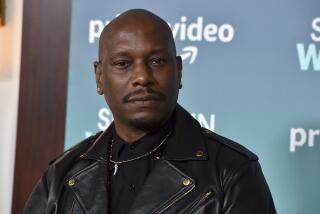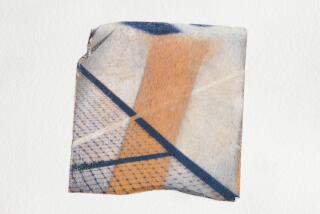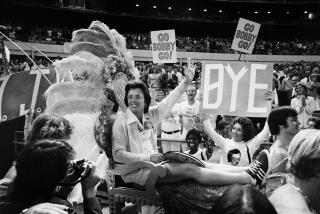Tennis Champion Was a Pioneer
- Share via
Althea Gibson, the daughter of a South Carolina sharecropper who became the first African American player, man or woman, to win the U.S. Open tennis tournament, Wimbledon and the French Open, died Sunday. She was 76.
Gibson died of respiratory failure at a hospital in East Orange, N.J., according to Fran Gray, her friend and co-founder of the Althea Gibson Foundation. Gibson had been in poor health for several years, Gray said, suffering from arthritis, high blood pressure and strokes.
A pioneer in sports as the first black player to compete at the U.S. nationals in 1950 -- only three years after Jackie Robinson had integrated major league baseball -- the 5-foot-11 Gibson was an athlete of uncommon strength and elegance.
She integrated Wimbledon in 1951 and won the French Open title in 1956, but it was in 1957 -- when she won Wimbledon and the U.S. Open at Forest Hills, N.Y. -- that Gibson’s history-making reputation was made. She received a ticker-tape parade in New York City, then came back a year later and successfully defended both titles.
Her triumphs occurred a full decade before the better-known Arthur Ashe brought down more racial barriers in men’s tennis.
“We all know people who influence us, and, if we are lucky, we meet a few in our lives who improve us,” said former tennis great Billie Jean King, who is now the captain of the U.S. Federation Cup. “Althea Gibson improved my life and the lives of countless others. She was the first to break so many barriers and from the first time I saw her play -- when I was 13 years old -- she became, and remained, one of my true heroines.”
Born in Silver, S.C., Gibson was the oldest of five children of Daniel and Annie B. Gibson. Before she was a year old, the family moved to a crowded Harlem tenement and it was on a neighborhood street, when she was 12 years old, that Althea’s tennis talent was discovered.
“Althea was playing paddle tennis,” Gray said, “and a young man, a bandleader named Buddy Walker, took note of her strength and style and was impressed.”
Walker, Gray said, contacted coaches at the American Tennis Assn., the organization that took the place of the United States Tennis Assn. for black players who were forbidden membership in the USTA. Gibson grew up poor and went through a series of menial jobs but continued with her tennis lessons.
From the outset, Gray said, “Her talent was very visible.”
“Althea’s serve, even with a wooden racket, was absolutely spectacular,” said Gussie Moran, the tennis player from the 1940s who had become famous for her game and creative tennis clothing. “Her serve in the 1950s was as strong as the serves we see today.”
Zina Garrison, who became the second black woman to reach a Wimbledon final in 1990, said Gibson was always after Garrison to improve Garrison’s serve. “She was always trying to get me to serve harder and learn to volley better,” said Garrison, who visited Gibson this month on the day after the U.S. Open. “She still loved the game very much.”
But Garrison said that although Gibson didn’t talk often about her experiences with racism and sexism, “those experiences were very bitter” for her. “She usually tried to stay positive,” Garrison said, “but sometimes she did bring up the bitterness to me.”
In 1942, the 15-year-old Gibson won the New York State Open girls’ singles title. Her evident talent caused the members of a local club to pool their money and send Gibson to the ATA’s national championship in Pennsylvania. It even attracted the attention of boxing champion Sugar Ray Robinson, who added his financial support. By the time she was 18, two prominent black physicians, Dr. H.E. Eaton and Dr. Walter Johnson -- who would also be instrumental in the career of Ashe -- told Gibson they would bankroll her tennis career if she would continue her education.
Gibson even lived with the Eaton family in Wilmington, N.C., where she played tennis on his grass court and finished high school and received a college scholarship to Florida A&M.; Eaton helped Gibson, while she was in Wilmington, to cultivate the grace and dignity she would need in breaking barriers on and off the tennis court. After improving her game in college, Gibson hoped to be invited to play the prestigious summer grass-court circuit sponsored by the United States Lawn Tennis Assn. No invitation came, but Gibson received backing from an unexpected corner -- other players. In an article in the American Lawn Tennis magazine, Alice Marble, a U.S. National Champion, wrote:
“I think it’s time we faced a few factors. If tennis is a game for ladies and gentlemen, it’s also time we acted like gentlepeople and less like sanctimonious hypocrites....
“If Althea Gibson represents a challenge to the present crop of women players, it’s only fair that they should meet that challenge on the courts, where tennis is played.”
Moran said: “Generally, the players themselves all accepted Althea and appreciated her for her talent. It was from the fans and sometimes officials where Althea was heckled and treated badly.” It was Gibson’s steely composure that impressed Moran.
“She took all the [stuff] handed out,” Moran said, “with everybody staring at her, glaring at her. It seemed so strange to everybody -- all of a sudden, in a sea of white faces wearing white clothes, there came this tall, strong black woman. I consider she had amazing concentration to not only play but to play well.”
Gibson won 11 Grand Slam titles in her career. Her first Wimbledon title was in doubles with Angela Buxton of England in 1956.
But because Gibson was playing in the era when only amateurs were eligible for the biggest tennis tournaments, and there was no prize money and no women’s professional circuit, she retired in 1958.
Gibson took a shot at professional golf with the LPGA -- the women’s tour -- but had little success. She even toured with the Harlem Globetrotters, doing tennis exhibitions at halftime.
Moran recalled that Gibson had a beautiful singing voice and recorded an album, “Althea Gibson Sings.” She had a small role in John Wayne’s film, “The Horse Soldiers,” and she titled her autobiography “I Always Wanted to Be Somebody.” Gibson also held jobs as a teaching pro, worked for the Essex County (N.J.) Parks Commission and was athletic commissioner for the state of New Jersey. In 1988, she presented her Wimbledon trophies to the Smithsonian Institution’s National Museum of American History.
But by the mid-1990s, Gibson was in bad financial shape. “Donations began coming from around the world, large and small,” Gray said. “Until then, I don’t think Althea realized how much she was appreciated.”
For the last decade, Gibson had lived a nearly solitary existence, accepting few visitors.
Even when the USTA honored Gibson with a special night at the 2002 U.S. Open, Gibson did not attend.
“She was just tired,” Gray said. “Imagine having been the only African American icon for nearly 50 years. People would want to talk to her, but Althea would say no. She said she couldn’t remember a lot of things, so people would consider her senile and she was always a private person. She’d come out of herself to do what she needed to do, but basically she was a very private person.”
David Dinkins, the former mayor of New York who was a friend of Gibson and a tennis fan, noted that even though Gibson broke racial barriers a full decade before Ashe, “a lot of people don’t even realize what Althea did. I don’t think she received enough credit.”
After Gibson retired, there were few black female players on the professional tour until Garrison and Lori McNeil cracked the top 20 in the 1980s.
In 1999, Serena Williams became the second black female winner at the U.S. Open, and Garrison said Gibson told her, “I feel as if a big burden has been lifted from me.” In 2000, Venus Williams became the second black woman to win Wimbledon.
“I am grateful to Althea Gibson for having the strength and courage to break through the racial barriers in tennis,” Venus Williams said Sunday in a statement. “Althea Gibson was the first African American woman to rank No. 1 and win Wimbledon and I am honored to have followed in such great footsteps. Her accomplishments set the stage for my success, and through players like myself and Serena and many others to come, her legacy will live on.”
Gibson had been married twice, to William Darben in 1965 and to her coach, Sydney Llewellyn, in 1983. Both men are deceased. She had no children. Gray said she is survived by her only brother, Daniel Gibson Jr., in Virginia and a sister, Lillian Chisholm, in New York City.
As of Sunday evening, funeral arrangements were pending, though Gray asked that in lieu of flowers, donations be made to the Althea Gibson Foundation, which sponsors academic scholarships.
More to Read
Go beyond the scoreboard
Get the latest on L.A.'s teams in the daily Sports Report newsletter.
You may occasionally receive promotional content from the Los Angeles Times.










